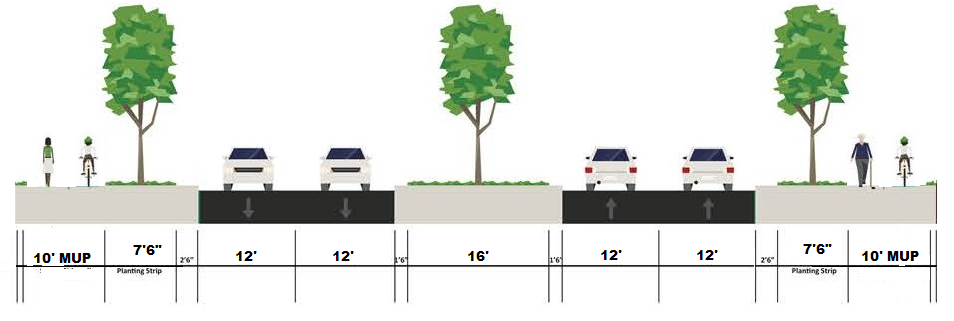South Fork Parkway
Current Status
In December 2021, City Council agreed to accept the South Fork Parkway as a city street so that it could be constructed by private development in a way that is consistent with our City's visions for both transportation and land use in this area.
Per Chapter 16 of the Land Development Code, any submitted plans along this adopted thoroughfare will be required to construct the proposed street within the borders of their development.
DelWebb, which was approved in May 2020, will be responsible for the construction of the first segment connecting Armstrong Ford Road to Nixon Road as a part of their conditions of approval. Development plans can be found HERE.
Proposed Typical Cross-Section

Origin and History
In 1995, the Gaston Cleveland Lincoln Metropolitan Planning Organization (GCLMPO) analyzed the potential for a new continuous roadway running north-south that would avoid congested downtown areas, better serve traffic, and improve quality of life for those living near the existing routes. They referred to the future corridor as the Belmont-Mount Holly Connector, and planned for this facility to become a four-lane divided highway incorporating bicycle and pedestrian facilities within its design. The alignment was intended to connect from South Point Road up to Armstrong Ford Road, and then extending further north into Mount Holly. This roadway was envisioned for construction by NCDOT in 2010, with plans to design the corridor to accommodate 2030 traffic projections.
In 2002, a functional design for this corridor was completed by NCDOT, which is required when new roadway location alternatives are being studied. This process includes preliminary capacity analysis and location mapping, but is still very high level.
In 2020, the GCLMPO submitted this project for scoring in SPOT 6.0, NCDOT's strategic prioritization process. Project scoring was halted due to NCDOT's insufficient funding for new roadway projects, further delaying the potential for state funding to construct this roadway.
In 2021, due to growing development interest along the identified route, NCDOT agreed to begin an Express Design for the corridor to further refine the identified alignment and its intended design. During initial stakeholder discussions, city staff learned that NCDOT's desired design speed for this facility was 50 MPH minimum. The City's adopted Comprehensive Land Use Plan notes a desired speed of 35 MPH for a four-lane divided boulevard. This difference in vision ultimately led to city council agreeing to accept the segment of this alignment south of Armstrong Ford Road as a city street.
